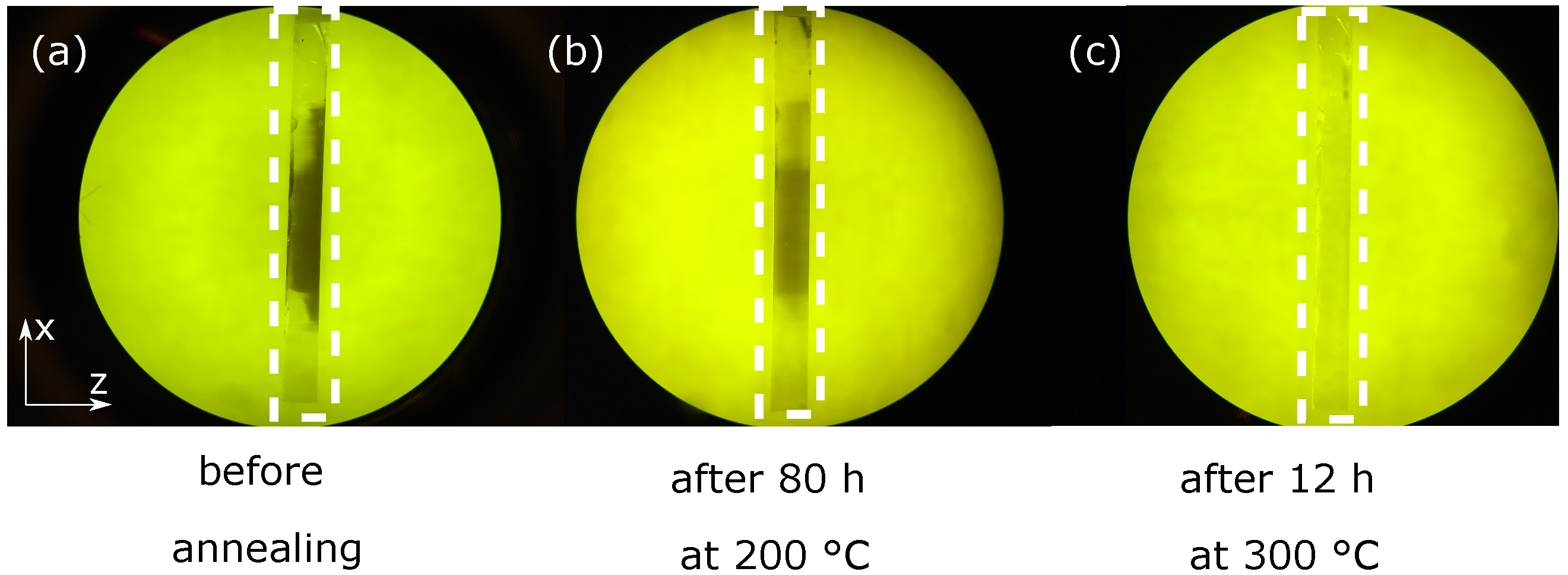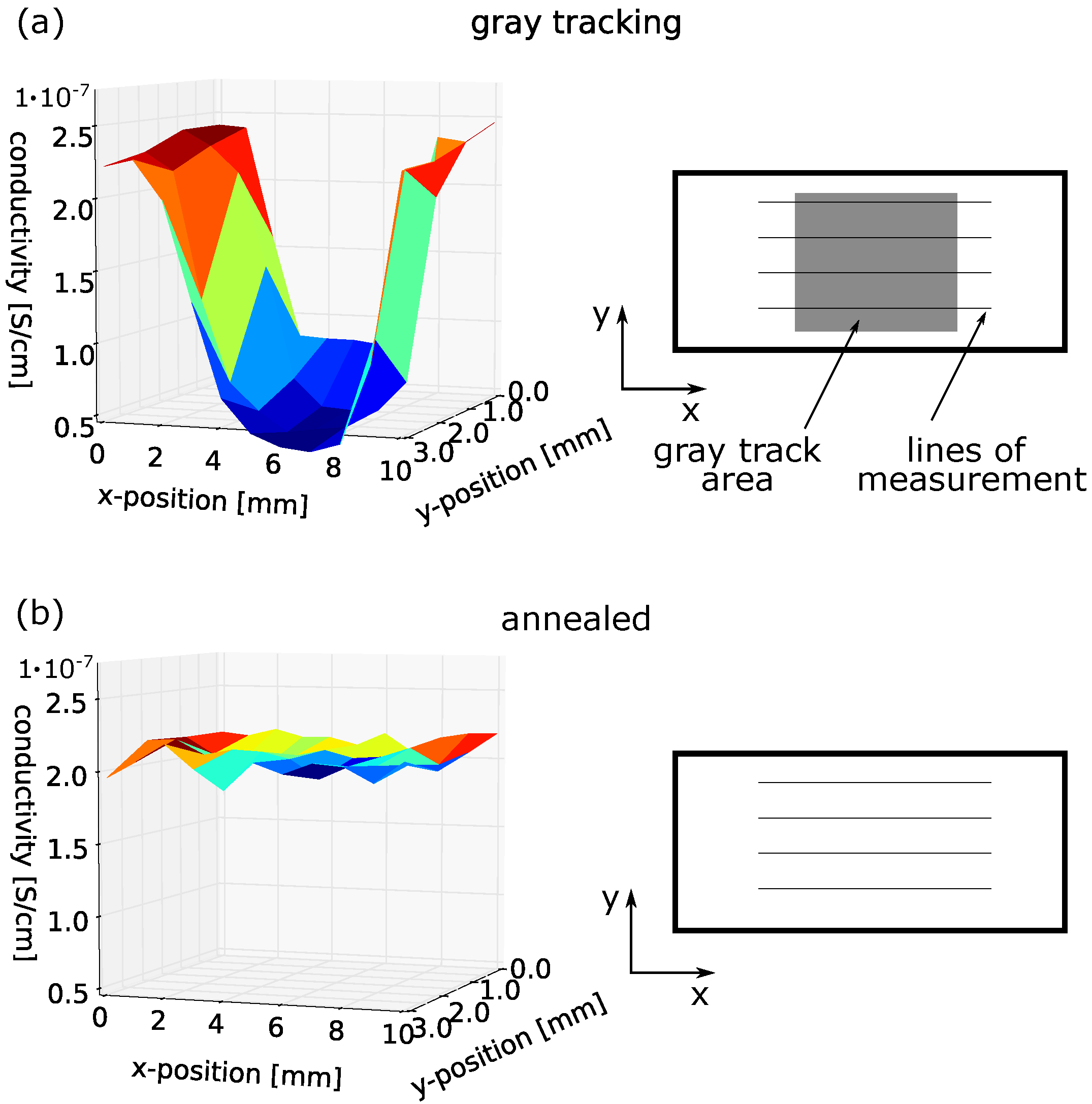DC Ionic Conductivity in KTP and Its Isomorphs: Properties, Methods for Suppression, and Its Connection to Gray Tracking
Abstract
:1. Introduction
2. Experimental Methods
3. Results
3.1. Reducing the Ionic Conductivity in KTP
3.2. Ionic Conductivity in Gray-Tracked Areas
4. Conclusions
Author Contributions
Funding
Data Availability Statement
Conflicts of Interest
References
- Ouvrard, M.L. Recherches sur les phosphate double de titane, d’étain et de cuivre. Comptes Rendus 1890, 111, 177–179. [Google Scholar]
- Masse, R.; Grenier, J.C. Study of the monophosphates of type M1TiOpO4 where M1 = K, Rb and Tl. Bull. Soc. Fr. Minéral. Cristallogr. 1971, 94, 437. [Google Scholar]
- Gandhi, J.R.; Vijayalakshmi, B.; Rathnakumari, M.; Sureshkumar, P. Growth of Pure and Mo Doped Potassium Titanyl Phosphate (KTP) Crystals: Influence of KTP/Flux Ratios on the Growth Morphology. J. Miner. Mater. Charact. Eng. 2011, 10, 683–691. [Google Scholar]
- Bordui, P.F.; Jacco, J.C. Viscosity and density of solutions used in high-temperature solution growth of KTiOPO4 (KTP). J. Cryst. Growth 1987, 82, 351–355. [Google Scholar] [CrossRef]
- Morris, P.; Ferretti, A.; Bierlein, J.; Loiacono, G. Reduction of the ionic conductivity of flux grown KTiOPO4 crystals. J. Cryst. Growth 1991, 109, 361–366. [Google Scholar] [CrossRef]
- Kugel, V.; Roseman, G.; Angert, N.; Yaschin, E.; Roth, M. Domain inversion in KTiOPO4 crystal near the Curie point. J. Appl. Phys. 1994, 76, 4823–4826. [Google Scholar] [CrossRef]
- Roelofs, M.G. Identification of Ti3+ in potassium titanyl phosphate and its possible role in laser damage. J. Appl. Phys. 1989, 65, 4976–4982. [Google Scholar] [CrossRef]
- Mohamadou, B.; Kugel, G.E.; Brehat, F.; Wyncke, B.; Marnier, G.; Simon, P. High-temperature vibrational spectra, relaxation and ionic conductivity effects in KTiOPO4. J. Phys. Condens. Matter 1991, 3, 9489–9501. [Google Scholar] [CrossRef]
- Choi, B.; Kim, J.; Kim, J. Ionic conduction associated with polaronic hopping in KTiOPO4 single crystal. Solid State Commun. 1992, 84, 1077–1080. [Google Scholar] [CrossRef]
- Yashima, M.; Komatsu, T. Order-disorder and displacive components in the ferroelectric-paraelectric phase transition of potassium titanyl phosphate KTiOPO4. Chem. Commun. 2009, 9, 1070. [Google Scholar] [CrossRef]
- Eigner, C.; Padberg, L.; Santandrea, M.; Herrmann, H.; Brecht, B.; Silberhorn, C. Spatially single mode photon pair source at 800 nm in periodically poled Rubidium exchanged KTP waveguides. Opt. Express 2020, 28, 32925–32935. [Google Scholar] [CrossRef] [PubMed]
- Furusawa, S.; Hayasi, H.; Ishibashi, Y.; Miyamoto, A.; Sasaki, T. Ionic Conductivity of Quasi-One-Dimensional Superionic Conductor KTiOPO4(KTP) Single Crystal. J. Phys. Soc. Jpn. 1993, 62, 183–195. [Google Scholar] [CrossRef]
- Eigner, C.; Santandrea, M.; Padberg, L.; Volk, M.F.; Rüter, C.E.; Herrmann, H.; Kip, D.; Silberhorn, C. Periodically poled ridge waveguides in KTP for second harmonic generation in the UV regime. Opt. Express 2018, 26, 28827. [Google Scholar] [CrossRef] [PubMed]
- Canalias, C.; Hirohashi, J.; Pasiskevicius, V.; Laurell, F. Polarization-switching characteristics of flux-grown KTiOPO4 and RbTiOPO4 at room temperature. J. Appl. Phys. 2005, 97, 124105. [Google Scholar] [CrossRef]
- Rosenman, G.; Skliar, A.; Eger, D.; Oron, M.; Katz, M. Low temperature periodic electrical poling of flux-grown KTiOPO4 and isomorphic crystals. Appl. Phys. Lett. 1998, 73, 3650–3652. [Google Scholar] [CrossRef]
- Choi, B.C.; Moon, B.K.; Seo, H.J.; Park, J.H.; Kim, C.S. Impedance spectroscopy of KTiOPO4 single crystal in the temperature range −100 to 100 °C. Appl. Phys. A Mater. Sci. Process. 2004, 78, 745–748. [Google Scholar] [CrossRef]
- Jiang, Q.; Womersley, M.N.; Thomas, P.A.; Rourke, J.P.; Hutton, K.B.; Ward, R.C.C. Ferroelectric, conductive, and dielectric properties of KTiOPO4 at low temperature. Phys. Rev. B 2002, 66, 094102. [Google Scholar] [CrossRef]
- Moorthy, S.G.; Kumar, F.J.; Kannan, C.V.; Subramanian, C.; Ramasamy, P. Conductivity and dielectric studies on flux grown KTiOPO4 single crystals. Ferroelectrics 1999, 230, 175–180. [Google Scholar] [CrossRef]
- Theerthan, R.A.; Menaert, B.; Boulanger, B.; Maglione, M. Linking ionic conductivity and piezoelectric resonance in KTiOPO4. Phys. Rev. B 2012, 85, 024103. [Google Scholar] [CrossRef]
- Sorokin, N.I.; Shaldin, Y.V. Ionic Conductivity of KTiOPO4 Single Crystals Grown by Flux Crystallization under Different Conditions. Crystallogr. Rep. 2018, 63, 780–783. [Google Scholar] [CrossRef]
- Bierlein, J.D.; Arweiler, C.B. Electro-optic and dielectric properties of KTiOPO4. Appl. Phys. Lett. 1986, 49, 917–919. [Google Scholar] [CrossRef]
- Guan, Q.; Wang, J.; Cui, W.; Wei, J.; Liu, Y.; Yin, X. DC Conductivity of Potassium Titanyl Phosphate Crystal along ITS Z-AXIS. MRS Proc. 1998, 527, 519–523. [Google Scholar] [CrossRef]
- Zhang, Q.; Feng, G.; Han, J.; Li, B.; Zhu, Q.; Xie, X. High repetition rate laser pulse induced damage in KTP crystal: Gray-tracking and catastrophic damage. Opt. Int. J. Light Electron Opt. 2011, 122, 1313–1318. [Google Scholar] [CrossRef]
- Maslov, V.A.; Mikhailov, V.A.; Shaunin, O.P.; Shcherbakov, I.A. Nonlinear absorption in KTP crystals. Quantum Electron. 1997, 27, 356–359. [Google Scholar] [CrossRef]
- Loiacono, G.M.; Loiacono, D.N.; McGee, T.; Babb, M. Laser damage formation in KTiOPO4 and KTiOAsO4 crystals: Grey tracks. J. Appl. Phys. 1992, 72, 2705–2712. [Google Scholar] [CrossRef]
- Scripsick, M.P.; Edwards, G.J.; Halliburton, L.E.; Belt, R.F.; Loiacono, G.M. Effect of crystal growth on Ti3+ centers in KTiOPO4. J. Appl. Phys. 1994, 76, 773–776. [Google Scholar] [CrossRef]
- Bocchini, A.; Neufeld, S.; Gerstmann, U.; Schmidt, W.G. Oxygen and potassium vacancies in KTP calculated from first principles. J. Phys. Condens. Matter 2019, 31, 385401. [Google Scholar] [CrossRef]
- Bocchini, A.; Eigner, C.; Silberhorn, C.; Schmidt, W.G.; Gerstmann, U. Understanding gray track formation in KTP: Ti3+ centers studied from first principles. Phys. Rev. Mater. 2020, 4, 124402. [Google Scholar] [CrossRef]
- Bocchini, A.; Gerstmann, U.; Schmidt, W.G. Oxygen vacancies in KTiOPO4: Optical absorption from hybrid DFT. Phys. Rev. 2022, 105, 205118. [Google Scholar] [CrossRef]
- Terashima, K.; Takena, M.; Kawachi, M. Transparency Improvement of Potassium Titanyl Phosphate (KTP) Crystals by Annealing under Oxygen Atmosphere. Jpn. J. Appl. Phys. 1991, 30, 497–499. [Google Scholar] [CrossRef]
- Fedotov, S.S.; Samarin, A.S.; Nikitina, V.A.; Aksyonov, D.A.; Sokolov, S.A.; Zhugayevych, A.; Stevenson, K.J.; Khasanova, N.R.; Abakumov, A.M.; Antipov, E.V. Reversible facile Rb+ and K+ ions de/insertion in a KTiOPO4-type RbVPO4F cathode material. J. Mater. Chem. A 2018, 6, 14420–14430. [Google Scholar] [CrossRef]
- Huang, J.; Cai, X.; Yin, H.; Li, Y.; Lin, W.; Huang, S.; Zhang, Y. A New Candidate in Polyanionic Compounds for a Potassium-Ion Battery Cathode: KTiOPO4. J. Phys. Chem. Lett. 2021, 12, 2721–2726. [Google Scholar] [CrossRef] [PubMed]
- Huang, J.; Cai, X.; Li, Y.; Fang, Z.; Li, Y.; Lin, W.; Huang, S.; Zhang, Y. DFT investigations of KTiOPO4Mx (M = K, Na, and Li) anodes for alkali-ion battery. J. Chem. Phys. 2022, 156, 204702. [Google Scholar] [CrossRef] [PubMed]





Publisher’s Note: MDPI stays neutral with regard to jurisdictional claims in published maps and institutional affiliations. |
© 2022 by the authors. Licensee MDPI, Basel, Switzerland. This article is an open access article distributed under the terms and conditions of the Creative Commons Attribution (CC BY) license (https://creativecommons.org/licenses/by/4.0/).
Share and Cite
Padberg, L.; Quiring, V.; Bocchini, A.; Santandrea, M.; Gerstmann, U.; Schmidt, W.G.; Silberhorn, C.; Eigner, C. DC Ionic Conductivity in KTP and Its Isomorphs: Properties, Methods for Suppression, and Its Connection to Gray Tracking. Crystals 2022, 12, 1359. https://doi.org/10.3390/cryst12101359
Padberg L, Quiring V, Bocchini A, Santandrea M, Gerstmann U, Schmidt WG, Silberhorn C, Eigner C. DC Ionic Conductivity in KTP and Its Isomorphs: Properties, Methods for Suppression, and Its Connection to Gray Tracking. Crystals. 2022; 12(10):1359. https://doi.org/10.3390/cryst12101359
Chicago/Turabian StylePadberg, Laura, Viktor Quiring, Adriana Bocchini, Matteo Santandrea, Uwe Gerstmann, Wolf Gero Schmidt, Christine Silberhorn, and Christof Eigner. 2022. "DC Ionic Conductivity in KTP and Its Isomorphs: Properties, Methods for Suppression, and Its Connection to Gray Tracking" Crystals 12, no. 10: 1359. https://doi.org/10.3390/cryst12101359





